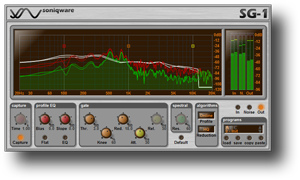 Many thanks to @LondonShortwave, on Twitter, who made a video showing how to use a GarageBand plugin to filter noise out of shortwave audio in real time. He describes this on his YouTube channel:
Many thanks to @LondonShortwave, on Twitter, who made a video showing how to use a GarageBand plugin to filter noise out of shortwave audio in real time. He describes this on his YouTube channel:
“I recently discovered a Mac AudioUnit plugin called Soniqware SG-1 that allows real-time noise filtering based on a brief noise sample (sometimes referred to as the “noise profile” or the “noise fingerprint”). This video shows it being applied to shortwave radio signals, which I believe is a first, as I have been unable to find anyone else who has already done it. In a number of cases, it turns laborious DXing into armchair listening.
The antenna used in these experiments is a Wellbrook ALA1530SP-1 and is positioned indoors. More information is contained in the first few seconds of the video.”
Click here to watch the video on YouTube.
Note that GarageBand is an application only available on the Mac OS X platform. Fortunately, it comes free with every new Apple computer purchase. You can find the Soniqware SG-1 spectral noise gate plugin by clicking here.
Be sure to follow @LondonShortwave on Twitter: http://twitter.com/LondonShortwave

I do the same with ReaFir, for both TX and RX. Great uses.
But…but…the noise is the best part of shortwave radio!
Seriously, folks…though I have applied noise reduction from time to time on shortwave audio, the “improved” version sounds awful to me…full of digital artifacts, very fatiguing to my ear.
I couldn’t agree more, David. The noise makes the medium and I wouldn’t have it any other way.
I think DSP can be a useful tool, though, to dig a station ID out of the static or (for ham radio operators) to make it easier to communicate in noisy band conditions. Otherwise, it comes with its own digital artifacts and sometimes I find that the filter between my ears can pull out faint voices better.
-Thomas
I’ve messed around with noise reduction plugins for over a dozen years, and have tried to clean up all sorts of dodgy audio. And while I haven’t used this particular piece of software (and I imagine such technology gets better gradually), I mostly agree with David. Trading some degree of clarity for some unwanted weirdness is often not pretty.
However, it can be a nice tool to have in your kit. As listeners to shortwave are well aware, weak reception and interference of various kinds can render content nearly impossible to discern what you are hearing (or where it is coming from).
Some static and clicks and pops can clean up quite nicely with a slight application of noise reduction. More complex forms of noise and interference are more problematic. I often find that the more noise you take out of the audio the more you mutate the quality and realism of the content you’re trying to hear or understand. In general, keeping the digital “cleaning” to a minimum usually gives the best result. And it’s certainly not something I’d use all the time.
Now that’s AMAZNG!